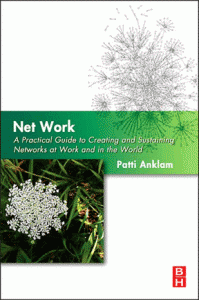“Leave it to Patti Anklam to write such an enlivening and well-written account of how various forms of networking and networks are transforming how we work.”
— Larry Prusak, Distinguished Fellow, Babson College“…when it comes to practical ideas for discovering, creating, and sustaining ‘people networks’ of all kinds, Patti has no equal—she really gets it.”
—Vik Muiznieks, VP, Alcatel-Lucent“Understanding and leading networks are critical competencies for today’s business leaders. Anklam has broken new ground by bringing together diverse perspectives and case studies into a deeply practical guide to creating value in networks.”
—Ross Dawson, Chairman Future Exploration Network
Synopsis
Patti Anklam provides a guide for leaders and participants to work within and lead purposeful social networks in the world. Awareness of networks and networked organizations has reached the mainstream of the business publishing world, as evidenced in the increasing number of articles in such publications as the Harvard Business Review and the Sloan Management Review. Many graduate business school programs now teach social network analysis and network theory.
Networks exist outside of corporations as well. Everyone participates in multiple networks, including the informal family, community, work, and their purely social networks of friends. Formal networks include civic organizations like Rotary International, alumni groups, and business and professional groups. The latter have all evolved distinct governance models, norms for joining and participating, legacy databases, membership rolls, and very public identities.
There is yet another class of network that is not yet well defined, and for which the norms and governance models are emerging-networks such as inter-company and intra-company learning and collaboration networks; independent consultants who share common interests and passions who want to remain independent but work collaboratively and consistently with like-minded others. They can be geographically local business networks; web-based virtual learning groups and communities; or global action networks destined to make the world a better place.
The purpose of this book is to provide a taxonomy and guidebook to these emergent networks, with a specific focus on helping leaders and participants to create and sustain successful networks. It will address the need for articulating a governance model and norms, selecting and using appropriate tools, and expectations for how the network will grow and change over time.
Contents
“Chapter 1. The Principles of Net Work:” describes assumptions about the nature of networks with a fundamental assertion that all networks can be described using a basic set of properties.
“Chapter 2. The Business of Net Work:” evidence for the increasing prevalence of networks in organizations of all types, including corporations and nonprofits, and the network view that is driving many organizations to establish networks that cross organizational boundaries.
Chapters 3 through 6 set out the core facets — purpose, structure, style, and value — that describe network properties.
You can describe a network based on its purpose (Chapter 3), structure (Chapter 4), and style (Chapter 5), and you can identify its value-producingprocesses (Chapter 6).
Chapters 7, 8, and 9 introduce tools and methods for applying the “network lens” in working with networks. Chapter 7 introduces the design and evolution of networks. Chapter 8 describes methods for examining and diagnosing the structure and health of a network (methods I use in my consulting practice). Chapter 9 provides guidance for managing a network through transitions.
Chapter 10 summarizes the imperatives of “Net Work” for leaders today: the new work required to create and sustain purposeful and thriving “nets” inside their organizations and outside.
As an organizational form, networks will never replace hierarchical structures or markets, but it is now clear that network forms (and they are varied) offer a range of choices for managing people, ideas, and work that were not previously available. I hope that bringing all these aspects of networks into one place, we can start on the road to a common language of networks and an understanding of the “net work” required making them successful.
Purchase now:
Net Work:A Practical Guide to Creating and Sustaining Networks at Work and
in the World![]()

